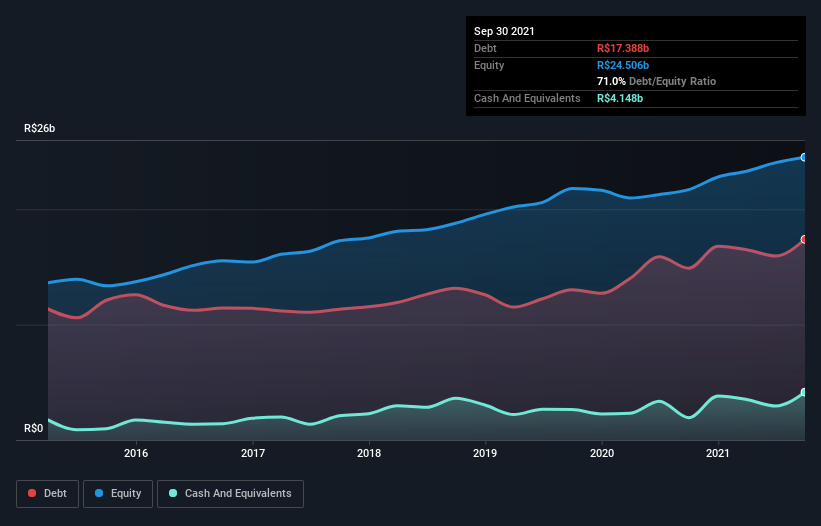- Brazil
- /
- Water Utilities
- /
- BOVESPA:SBSP3
Companhia de Saneamento Básico do Estado de São Paulo - SABESP (BVMF:SBSP3) Takes On Some Risk With Its Use Of Debt

David Iben put it well when he said, 'Volatility is not a risk we care about. What we care about is avoiding the permanent loss of capital.' It's only natural to consider a company's balance sheet when you examine how risky it is, since debt is often involved when a business collapses. We note that Companhia de Saneamento Básico do Estado de São Paulo - SABESP (BVMF:SBSP3) does have debt on its balance sheet. But should shareholders be worried about its use of debt?
When Is Debt Dangerous?
Debt assists a business until the business has trouble paying it off, either with new capital or with free cash flow. Ultimately, if the company can't fulfill its legal obligations to repay debt, shareholders could walk away with nothing. However, a more frequent (but still costly) occurrence is where a company must issue shares at bargain-basement prices, permanently diluting shareholders, just to shore up its balance sheet. Of course, debt can be an important tool in businesses, particularly capital heavy businesses. The first thing to do when considering how much debt a business uses is to look at its cash and debt together.
Check out our latest analysis for Companhia de Saneamento Básico do Estado de São Paulo - SABESP
How Much Debt Does Companhia de Saneamento Básico do Estado de São Paulo - SABESP Carry?
You can click the graphic below for the historical numbers, but it shows that as of September 2021 Companhia de Saneamento Básico do Estado de São Paulo - SABESP had R$17.4b of debt, an increase on R$14.9b, over one year. On the flip side, it has R$4.15b in cash leading to net debt of about R$13.2b.

How Healthy Is Companhia de Saneamento Básico do Estado de São Paulo - SABESP's Balance Sheet?
Zooming in on the latest balance sheet data, we can see that Companhia de Saneamento Básico do Estado de São Paulo - SABESP had liabilities of R$6.14b due within 12 months and liabilities of R$22.4b due beyond that. Offsetting these obligations, it had cash of R$4.15b as well as receivables valued at R$2.59b due within 12 months. So it has liabilities totalling R$21.8b more than its cash and near-term receivables, combined.
This deficit is considerable relative to its market capitalization of R$24.9b, so it does suggest shareholders should keep an eye on Companhia de Saneamento Básico do Estado de São Paulo - SABESP's use of debt. This suggests shareholders would be heavily diluted if the company needed to shore up its balance sheet in a hurry.
In order to size up a company's debt relative to its earnings, we calculate its net debt divided by its earnings before interest, tax, depreciation, and amortization (EBITDA) and its earnings before interest and tax (EBIT) divided by its interest expense (its interest cover). This way, we consider both the absolute quantum of the debt, as well as the interest rates paid on it.
With a debt to EBITDA ratio of 2.0, Companhia de Saneamento Básico do Estado de São Paulo - SABESP uses debt artfully but responsibly. And the alluring interest cover (EBIT of 8.1 times interest expense) certainly does not do anything to dispel this impression. We saw Companhia de Saneamento Básico do Estado de São Paulo - SABESP grow its EBIT by 3.2% in the last twelve months. Whilst that hardly knocks our socks off it is a positive when it comes to debt. When analysing debt levels, the balance sheet is the obvious place to start. But it is future earnings, more than anything, that will determine Companhia de Saneamento Básico do Estado de São Paulo - SABESP's ability to maintain a healthy balance sheet going forward. So if you want to see what the professionals think, you might find this free report on analyst profit forecasts to be interesting.
Finally, while the tax-man may adore accounting profits, lenders only accept cold hard cash. So we clearly need to look at whether that EBIT is leading to corresponding free cash flow. In the last three years, Companhia de Saneamento Básico do Estado de São Paulo - SABESP's free cash flow amounted to 21% of its EBIT, less than we'd expect. That's not great, when it comes to paying down debt.
Our View
Neither Companhia de Saneamento Básico do Estado de São Paulo - SABESP's ability to handle its total liabilities nor its conversion of EBIT to free cash flow gave us confidence in its ability to take on more debt. But it seems to be able to cover its interest expense with its EBIT without much trouble. It's also worth noting that Companhia de Saneamento Básico do Estado de São Paulo - SABESP is in the Water Utilities industry, which is often considered to be quite defensive. When we consider all the factors discussed, it seems to us that Companhia de Saneamento Básico do Estado de São Paulo - SABESP is taking some risks with its use of debt. So while that leverage does boost returns on equity, we wouldn't really want to see it increase from here. The balance sheet is clearly the area to focus on when you are analysing debt. However, not all investment risk resides within the balance sheet - far from it. For instance, we've identified 1 warning sign for Companhia de Saneamento Básico do Estado de São Paulo - SABESP that you should be aware of.
Of course, if you're the type of investor who prefers buying stocks without the burden of debt, then don't hesitate to discover our exclusive list of net cash growth stocks, today.
New: AI Stock Screener & Alerts
Our new AI Stock Screener scans the market every day to uncover opportunities.
• Dividend Powerhouses (3%+ Yield)
• Undervalued Small Caps with Insider Buying
• High growth Tech and AI Companies
Or build your own from over 50 metrics.
Have feedback on this article? Concerned about the content? Get in touch with us directly. Alternatively, email editorial-team (at) simplywallst.com.
This article by Simply Wall St is general in nature. We provide commentary based on historical data and analyst forecasts only using an unbiased methodology and our articles are not intended to be financial advice. It does not constitute a recommendation to buy or sell any stock, and does not take account of your objectives, or your financial situation. We aim to bring you long-term focused analysis driven by fundamental data. Note that our analysis may not factor in the latest price-sensitive company announcements or qualitative material. Simply Wall St has no position in any stocks mentioned.
About BOVESPA:SBSP3
Companhia de Saneamento Básico do Estado de São Paulo - SABESP
Provides basic and environmental sanitation services in the São Paulo State, Brazil.
Outstanding track record and fair value.


